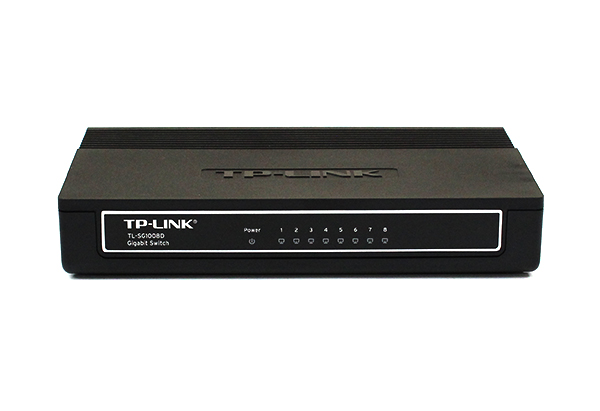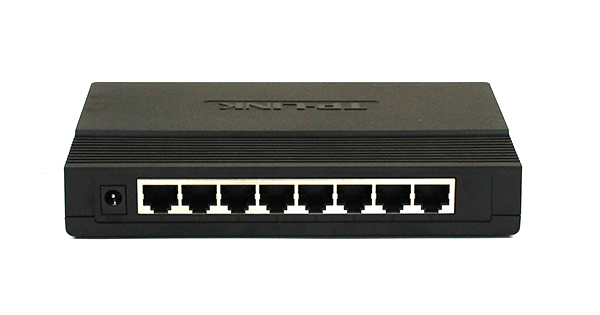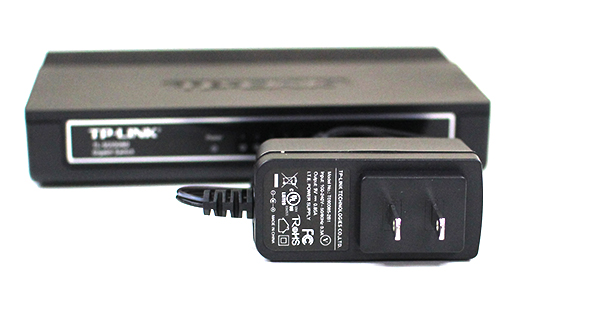The TP-LINK TL-SG1008D is a device on a mission: inexpensively provide eight switched gigabit Ethernet ports at the lowest price possible. For those wondering, we purchased the review sample for $28 at Amazon.com or $3.50 per port. It should be noted that TP-Link sells both a metal version of this switch as well as a plastic version. Today we are reviewing the plastic version. The metal version looks more interesting, but costs an additional $7.00, or 25% more. Although both are likely viable options, we decided to look at the plastic version purely from a cost perspective.
Look and Feel
Overall the TP-LINK TL-SG1008D (plastic model) feels inexpensive. The switch is very light due to using plastic versus a heavier steel construction found on NetGear and other switches. In terms of look, there are only very basic LEDs on the front.

There is not a lot of information provided out of this unit. One gets status LEDs by port and a power indicator. The unit does feature plastic “heatsink-like” fins on the chassis but these are not metallic. One great feature of the switch is a lack of a fan. This does two things. First, it lowers idle power consumption. Second, it keeps the unit silent. For home and small office applications, those are both very desirable features.
Performance Impressions
For performance specs, the TP-LINK TL-SG1008D advertises 10gbps switching capacity, so this is not a device meant to run at maximum speeds all the time. Eight gigabit ports in full duplex mode should allow for up to 16gbps in network capacity. Clearly, there is a disconnect there. With that being said, for 99.9% of home uses (estimating but the actual value is probably significantly higher) this is fine. We spent a few days generating “normal” traffic, one port streaming HD Netflix on a PC, four ports backing up files to a NAS that occupied two ports and two servers doing file transfers back and forth, the switch did not hiccup.

The rear of the unit is very plain. Major notes here are that there are no status LEDs on the ports themselves. Instead, one needs to look at the opposite side of the chassis to see if there is an active link. The second major note is that the unit does not have a Kensington lock port. Since the unit is made of lighter plastic, it is unlikely that a lock is much of a deterrent, but still is a feature many people look for.
TP-LINK TL-SG1008D Power Consumption
Overall power consumption on the TP-Link TL-SG1008D was better than expected. Boot power consumption peaked at 3w on the Extech 380803 True RMS power analyzer. Here are some quick stats:
- Boot power consumption: 3.0w
- Idle power consumption (no RJ-45 active): 1.0w
- Idle power consumption (2x RJ-45 active): 1.2w
- Idle with 8x RJ-45 gigabit links: 2.0w
- Active power consumption with 2x RJ-45 gigabit links: 2.0w
- Active power consumption with 8x RJ-45 gigabit links: 5.2w
Overall, a very impressive showing. The figures were captured using relatively short 2 meter CAT6 cables which generally lowers power consumption on modern switches. With that said, fanless operation certainly did lower overall power consumption.

One other point to note here is that TP-LINK utilizes a right angle power adapter. This is important because it does take up less space on most power strips. This is important because at this class/ cost of device, it generally makes sense to just purchase a different switch than a different surge protector/ APC to get the power port layout one needs.
TP-LINK TL-SG1008D Features
[tabgroup][tab title=”TP-LINK TL-SG1008D Features”]
- Innovative energy-efficient technology saves power up to 80%
- Supports IEEE 802.3x flow control for Full Duplex mode and backpressure for Half Duplex mode
- Non-blocking switching architecture that forwards and filters packets at full wire-speed for maximum throughput
- 10Gbps Switching Capacity
- 15K Jumbo frame improves performance of large data transfers
- Auto-MDI/MDIX eliminates the need for crossover cables
- Supports MAC address auto-learning and auto-aging
- Auto-negotiation ports provide smart integration between 10Mbps, 100Mbps and 1000Mbps hardware
- Fanless design ensures quiet operation
- Desktop or wall-mounting design
- Plug and Play design simplifies installation
[/tab][/tabgroup]
Conclusion
Overall the TP-LINK TL-SG1008D is not a device that is going to wow anyone with a slick management interface or advanced features. What it will do is inexpensively add ports to a user’s network while maintaining a very low power consumption profile. For those looking for a sturdier unit, it would certainly make sense to look at the $35 metal version with the 25% price premium.





I used a TL-SG1016 in a body shop I wired up and its a great switch. I am seriously considering a TL-SG2424 for when I get my Synology DS1813+ so I can do LACP on it.
We use these at work for diagnostics. We’ve also found a bunch of them rigged in various labs and cubicles. We never have seen one break down.
Quiet operation, low power, cheap and reliable is a great combination in this class of switch.
Highly recommended++
The TP Website now claims, the TL-SG1008D has a 16Gbps backplane. Look here:
http://www.tp-link.com/en/products/details/?model=TL-SG1008D#fea
The article doesn’t mention if the switch has different color to indicate the connection speed. The one I need to replace (broke after 10 years causing bad network performance) had a green color for 10/100 connections and orange for 1000. Does anybody know?
Thank you for the review, with these, can you an easy way to make the transition to Gigabit Ethernet?